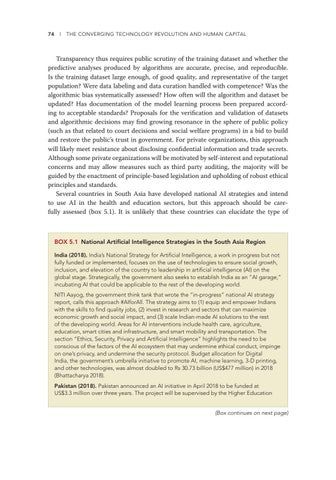74 l THE CONVERGING TECHNOLOGY REVOLUTION AND HUMAN CAPITAL
Transparency thus requires public scrutiny of the training dataset and whether the predictive analyses produced by algorithms are accurate, precise, and reproducible. Is the training dataset large enough, of good quality, and representative of the target population? Were data labeling and data curation handled with competence? Was the algorithmic bias systematically assessed? How often will the algorithm and dataset be updated? Has documentation of the model learning process been prepared according to acceptable standards? Proposals for the verification and validation of datasets and algorithmic decisions may find growing resonance in the sphere of public policy (such as that related to court decisions and social welfare programs) in a bid to build and restore the public’s trust in government. For private organizations, this approach will likely meet resistance about disclosing confidential information and trade secrets. Although some private organizations will be motivated by self-interest and reputational concerns and may allow measures such as third party auditing, the majority will be guided by the enactment of principle-based legislation and upholding of robust ethical principles and standards. Several countries in South Asia have developed national AI strategies and intend to use AI in the health and education sectors, but this approach should be carefully assessed (box 5.1). It is unlikely that these countries can elucidate the type of
BOX 5.1 National Artificial Intelligence Strategies in the South Asia Region India (2018). India’s National Strategy for Artificial Intelligence, a work in progress but not fully funded or implemented, focuses on the use of technologies to ensure social growth, inclusion, and elevation of the country to leadership in artificial intelligence (AI) on the global stage. Strategically, the government also seeks to establish India as an “AI garage,” incubating AI that could be applicable to the rest of the developing world. NITI Aayog, the government think tank that wrote the “in-progress” national AI strategy report, calls this approach #AIforAll. The strategy aims to (1) equip and empower Indians with the skills to find quality jobs, (2) invest in research and sectors that can maximize economic growth and social impact, and (3) scale Indian-made AI solutions to the rest of the developing world. Areas for AI interventions include health care, agriculture, education, smart cities and infrastructure, and smart mobility and transportation. The section “Ethics, Security, Privacy and Artificial Intelligence” highlights the need to be conscious of the factors of the AI ecosystem that may undermine ethical conduct, impinge on one’s privacy, and undermine the security protocol. Budget allocation for Digital India, the government’s umbrella initiative to promote AI, machine learning, 3-D printing, and other technologies, was almost doubled to Rs 30.73 billion (US$477 million) in 2018 (Bhattacharya 2018). Pakistan (2018). Pakistan announced an AI initiative in April 2018 to be funded at US$3.3 million over three years. The project will be supervised by the Higher Education (Box continues on next page)

